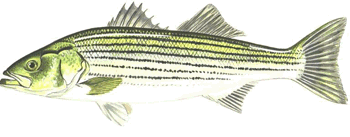Back to Previous Page
STRIPED BASS

At-a-Glance
- Scientific Name: Morone saxatilis
- Found in Illinois: Statewide
- State Average:
- State Record: 31 lbs/7 oz (1994)
- Best Lures: large minnows, spoons, spinners, crank baits, jigs, and crankbaits
Habitat: Striped bass are not native to Illinois and in their native habitats are anadramous, meaning they are born in freshwater, migrate to saltwater to mature, and then migrate to freshwater to spawn. While striped bass are typically found in coastal areas, landlocked populations do occur because of man-made barriers, such as dams. Typically, landlocked striped bass do not reproduce successfully, however, some habitats allow for more success. Some of these factors include an available abundance of forage fish, such as gizzard or threadfin shad. Another factor includes the presence of a large flowing river (~50 miles in length) that feeds the lake. This allows for the striped bass to migrate up the river to spawn.
Feeding and Habits: For adult striped bass, threadfin or gizzard shad are the dominant food items. Striped bass apparently feed very little while migrating up rivers to spawn and rarely feed during spawning periods.
Reproduction: Striped bass spawn in freshwater in a moderate (1.0 to 2.5 mph) to swift (2.6 to 4.0 mph) current. Striped bass eggs are spherical, nonadhesive and semi-buoyant. They have a bright green yolk. The suspension of eggs and larvae by currents is necessary for their survival; currents help hold the eggs and larvae in suspension. Water turbidity caused by suspended silt or clay is reported to increase egg hatchability and fry survival.



